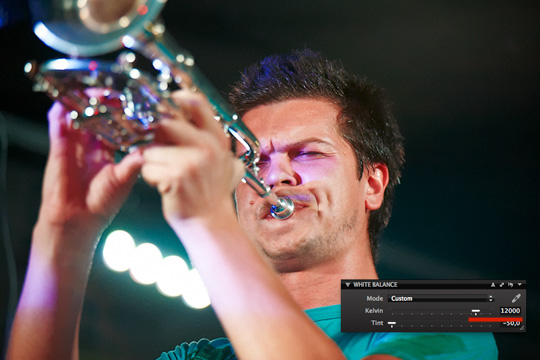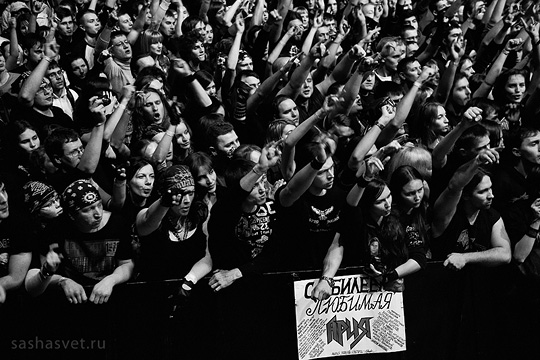I recently filmed a concert of "Aria" for the group's future photobook. And in the process of processing these photos, I got the idea to write an article about simple but very effective techniques for shooting concerts, which I often use.
ISO / Shutter speed / Aperture
With exposure settings, everything is simple and depends solely on the capabilities of your technique.
Does the camera calmly "hold" ISO 1600? Great, we're working at 1600. Do you have a vibration suppression telephoto? Super, which means that it can set the shutter speed a little longer without fear of ruining the picture with a shake.
Are you shooting with high-aperture optics? This means you can open the aperture harder and get more depth in the frame.
Do you have an entry-level DSLR with whale optics? Sadly, but not fatal - I started filming concerts with a camera that didn't even hold ISO 640, and I could only dream of high-aperture optics. And before, I filmed musicians on film and nothing, good shots also happened.
So, you are at a concert, standing in front of the stage in the photographer's box.
What exposure settings should I use?
Forget about automatic and "program" shooting modes; turn on manual - manual mode. We set the maximum comfortable ISO (some cameras have 800, others 2000), shutter speed 1/125, and "hole" 3.5. We make a test shot. We look. Is it too dark? We make the shutter speed longer, say, up to 1/80 or 1/100. Is it too light? We set the ISO below or close the hole to 4.5, or even 5.6.
All perfectly? Stop reading this article and start filming the concert!
Now a couple of nuances:
When shooting with long-focus optics, remember: the longer the focal length, the shorter the shutter speed will have to be set. Shooting from 200 mm, the shutter speed is 1 / 160-1 / 250. At slower shutter speeds, the shake is almost guaranteed.
Don't get carried away by open holes. The depth of the picture, the beautiful bokeh are all great, but open aperture = shallow depth of field, which means it will be more difficult to focus on the desired area. Therefore, when shooting a close-up portrait shot, you can set the aperture to 2.8, but you should only pen up to 1.8 / 1.4 in cases with very low light or using a shallow depth of field as an artistic technique. And if you take a general shot, it is better to cover the diaphragm to 5.6.
By the way, if the words shutter speed/aperture / ISO do not tell you about anything but only raise questions, I recommend reading our article "Exposure Basics"; everything will immediately become clearer.
2. Contrast
Don't be afraid to increase the contrast of the picture. Sometimes only by increasing the contrast and can you "draw out" a boring picture. The colors will become brighter, the picture "clearer," and even the dullest frame can become interesting.
Pay attention to the shots of different photographers from the same concert - some have bright and juicy photos, others are dull. That's right because everyone was shooting in the same conditions (with dull lighting), but those photographers who finished off the contrast got a more interesting picture.
Another very simple and effective processing technique is to add more contrast and then "dilute" the image with Shadow / Highlights (in Photoshop or RAW converter). Thus, we will get a contrasting picture at the same time while retaining the details in the highlights and shadows.
Read article : https://myshote.blogspot.com/2023/10/what-are-7-email-marketing-strategies.html
3. Experiment with color
Was there poor lighting at the concert? Do you want to break the hand of the light in three places? And what is the saddest thing - the photos turned out to be absolutely no color.
So change the picture! Feel free to change the color of your stage lighting if you feel your photography will benefit from it.
I can do this in 1000 different ways (like everything else in photo processing). The simplest and most effective is working with the white balance settings in the RAW converter.
We have a typical shot spoiled by poor lighting (the whole picture is filled with one color).
Let's see what you can do using the white balance settings.
I work with the Capture One Pro converter, but any decent RAW converter has WB processing functionality.
Obviously, with magenta in the frame, we have an overkill - move Tint to the left and add greenery.
Magenta was gone, but the colors of the picture became unhealthy cold. Not a problem - we increase the color temperature to 12,000 Kelvin:
For clarity:
Of course, you can still work on the color here, but this is just a couple of passes in the Raw converter, a matter of minutes, and the picture has become much more interesting.
I am speaking of color. Simple trick: make the foreground cool and the background warm. Or vice versa.
This is the same contrast, only in color, and works for the viewer just as flawlessly. Of course, lighting at a concert does not always allow you to use this technique, but if you succeed, be sure to use it and enhance the effect by processing the color.
Always try to enhance color accents.
During Helavisa's speech, photographers could not fail to please the blue back color, but by enhancing it during processing, you can get an even prettier picture:
For such manipulations with color, there are also hundreds of thousands of methods in processing. I recommend working with Selective Color in Photoshop or Capture's Color Editor (Capture One Pro). You can also read about the tools for working with color in the article "Photoshop Tutorials. How to create vibrant and saturated colors in Photoshop", which is interesting, of course.
4. B / W
When there was absolutely no lighting at the concert, and the picture looked very dull in color - transfer it to B / W, and the photo will immediately become more interesting. If it doesn't, it means that this frame will not save anything.
B / W pictures have one interesting feature - a black and white image focuses the viewer's attention on the details of the frame, a photo in b / w wants to be viewed especially for a long time (if there is something to look at, of course). That is why black and white portraits photography are so popular.
How does this apply to concert photography? Take a shot full of details, such as a photo of a crowd of fans, and convert it to b / w. The picture will immediately become more interesting - the color does not distract the viewer's attention from the details of the frame.
Take, take, and another take.
Do a lot of takes. Are you shooting a lot already? Shoot even more. Flash drives are now sold in bulk; cameras can quickly "thresh" RAVs. All conditions have been created to make 5-7-10 takes of each "key" moment.
How else? You can, of course, be lucky, and you will be able to "catch the moment" from the first take. Or you may not be lucky, and you will be left without a good photo, then you will regret it. I prefer to rake a ton of RAVs after shooting but not miss the shot.
A concert photographer cannot put lights on stage or communicate with musicians like a model in a studio. He can only shoot. That is why concert photography best illustrates that it is not the camera shooting but the person. There may be a dozen photographers at a concert. Everyone is filming from one point, with similar equipment, the same scene, and the same musicians. And everyone's photos come out different.
Read also: Action Camera Flashlight
Read also: Best Trail Camera
Alpha 7c mirrorless digital camera
















1 Comments
Thanks for visit.
ReplyDeletesingle hexagon painting
Please Do Not add Spam cemment